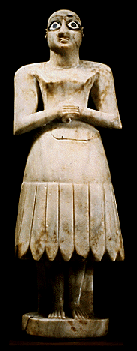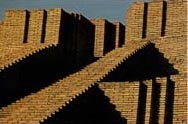

STONE AGE
BUILDING INDEX
STONE AGE
BUILDING
STANDING
STONES
NEWGRANGE
STONEHENGE
MALTA'S MEGALITHIC MARVELS
SKARA BRAE
HUNEBEDDEN
The Neolithics
The Neolithic Period (aka Stone Age) begins ca. 8000 BCE in the Near East, but it begins and ends at different times throughout the Old World and is defined by the presence of sedentary villages and domesticated plants and animals. The Neolithic in other parts of the Old World is defined by the appearance of these characteristics at different times; some parts of the world were still largely "pre-agricultural" early in these centuries.
The words 'neolithic' and 'megalithic' are often used in the same context. What is the difference? Neolithic stands for the period: the last period of the Stone Age in which people started using stone tools. Megalithic stones are literly 'big stones' ("Mega" means big and "lithos" means stone). So in the neolithic period the megalithic buildings were created by erecting 'big stones'.
 The earliest neolithic villages are found in the "Fertile Crescent" (see map). Later agricultural settlements appear in Greece, Bulgaria and Turkye to the west and the Indus Valley of Pakistan to the east. The neolithic appears independently in Southeast Asia and China. Neolithic buildings (dolmens, stone circles, menhirs, cromlechs, alignments of stones and temples) are found all over the world.
The earliest neolithic villages are found in the "Fertile Crescent" (see map). Later agricultural settlements appear in Greece, Bulgaria and Turkye to the west and the Indus Valley of Pakistan to the east. The neolithic appears independently in Southeast Asia and China. Neolithic buildings (dolmens, stone circles, menhirs, cromlechs, alignments of stones and temples) are found all over the world.
It is interesting to see that all over the world, in a timeperiod of several hundred years, people started to create enormous buildings and up until now no-one has been able to found out why and how they actually did it. In contraty of the Sumerians, most of the peoples living in the Stone Age didn't have the ability to write: how did this knowledge appear all over the world and how was the knowlegde kept for centuries? I wonder....
The Fertile Crescent
The Fertile Cresent is often called 'the cradle of civilization' and this just might be true. As it seems the oldest established civilizations had their home in the small strip of land from the Euphrates & Tigris to the area we now call Israel. Here, the first technical achievements were made. From about 3,000 BCE other cultures started to take over as they raided and conquered the valleys and, of course, the knowledge.
 Probably it were the Sumerians who developed the first civilization, when they settled in the area of Sumer. They came from the east or from the mountains of Elam, perhaps as early as 5,000 BCE to the swamps of Persia. They drained the swamps, developed flood control, invented the wheel, and so established a permanent agriculture. As successful trade developed with the surrounding areas, Sumerian villages and settlements grew into prosperous citystates, such as Ur, Eridu, Lagash, Nippur and Uruk.
Probably it were the Sumerians who developed the first civilization, when they settled in the area of Sumer. They came from the east or from the mountains of Elam, perhaps as early as 5,000 BCE to the swamps of Persia. They drained the swamps, developed flood control, invented the wheel, and so established a permanent agriculture. As successful trade developed with the surrounding areas, Sumerian villages and settlements grew into prosperous citystates, such as Ur, Eridu, Lagash, Nippur and Uruk.
They were the first to introduce advanced methods of irrigation. They were the first to fashion the plough which was attached to a beast of burden, while other tribes still worked the ground with sharpened sticks. One man led the animal, a second would drop seeds into the trench made by the plough. Basicly the same method is still used in modern agriculture.
 Scolars believe that the Sumerian states were under rule of a local god or godess. The system would have been bureaucratic, under the rule of a priesthood which oversaw the ritualistic and complex religion. High priests (and/or priestesses) represented the god or godess on earth and it was their duty to discern the will of the divine, which was done by reading sheep or goat entrails. The priests ruled from their ziggurats, high rising temples of sunbaked brick with outside staircases leading to the shrine on top.
Scolars believe that the Sumerian states were under rule of a local god or godess. The system would have been bureaucratic, under the rule of a priesthood which oversaw the ritualistic and complex religion. High priests (and/or priestesses) represented the god or godess on earth and it was their duty to discern the will of the divine, which was done by reading sheep or goat entrails. The priests ruled from their ziggurats, high rising temples of sunbaked brick with outside staircases leading to the shrine on top.
NEWGRANGE STONEHENGE MALTA'S MEGALITHIC MARVELS SKARA BRAE